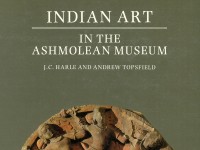Indian Art in the Ashmolean Museum
A catalogue of the Ashmolean’s collection of Indian art by J. C. Harle and Andrew Topsfield (published Oxford, 1987).

Publications online: 143 objects
- Reference URL
Actions
Part of a set with...
Stone pilaster
-
Literature notes
These two elaborate carved pillars are technically pilasters, since full-length portions of two adjacent sides remain uncarved. The Adina mosque at Pandua and the one at Gaur are the two earliest mosques to have survived in Bengal and unlike almost all of their successors they were built of stone. This was almost certainly thanks to the proximity of the Rajmahal hills in Bihar, the only source of stone for Bengal, both for building and for sculpture [see LI894.12]. The decoration consists mostly of flora or abstract motifs, although bunches of grapes (?) as well as bells can be identified. These would be acceptable to Muslims; on the other hand, the general nature of the decoration belongs to the stylistic koine of late North Indian architectural decoration, Hindu ornament having been increasingly formalized to the point of abstraction. The earlier mosques in western India, dating from the 12th century, made extensive use of materials taken from demolished Hindu temples, which raises the interesting possibility that these pillars were originally carved for a Hindu temple and re-used for the Adina Mosque.
There are identical pillars in the British Museum and the Royal Scottish Museum. -
Details
- Associated place
-
Asia › India › east India › West Bengal › Pandua › Adina mosque (probable place of creation)
- Date
- 2nd half of the 14th century
- Material and technique
- siltstone (ceriticised slate)
- Dimensions
- 110 x 27 x 25 cm max. (height x width x depth)
- Material index
- Technique index
- Object type index
- No. of items
- 1
- Accession no.
- EAX.2477.b
-
Further reading
Harle, J. C., and Andrew Topsfield, Indian Art in the Ashmolean Museum (Oxford: Ashmolean Museum, 1987), no. 49 on pp. 40-41, illus. p. 41
Location
Objects are sometimes moved to a different location. Our object location data is usually updated on a monthly basis. Contact the Jameel Study Centre if you are planning to visit the museum to see a particular object on display, or would like to arrange an appointment to see an object in our reserve collections.
Publications online
-

Indian Art in the Ashmolean Museum
These two elaborate carved pillars are technically pilasters, since full-length portions of two adjacent sides remain uncarved. The Adina mosque at Pandua and the one at Gaur are the two earliest mosques to have survived in Bengal and unlike almost all of their successors they were built of stone. This was almost certainly thanks to the proximity of the Rajmahal hills in Bihar, the only source of stone for Bengal, both for building and for sculpture [see LI894.12]. The decoration consists mostly of flora or abstract motifs, although bunches of grapes (?) as well as bells can be identified. These would be acceptable to Muslims; on the other hand, the general nature of the decoration belongs to the stylistic koine of late North Indian architectural decoration, Hindu ornament having been increasingly formalized to the point of abstraction. The earlier mosques in western India, dating from the 12th century, made extensive use of materials taken from demolished Hindu temples, which raises the interesting possibility that these pillars were originally carved for a Hindu temple and re-used for the Adina Mosque.
There are identical pillars in the British Museum and the Royal Scottish Museum. -

Indian Art in the Ashmolean Museum
These two elaborate carved pillars are technically pilasters, since full-length portions of two adjacent sides remain uncarved. The Adina mosque at Pandua and the one at Gaur are the two earliest mosques to have survived in Bengal and unlike almost all of their successors they were built of stone. This was almost certainly thanks to the proximity of the Rajmahal hills in Bihar, the only source of stone for Bengal, both for building and for sculpture [see LI894.12]. The decoration consists mostly of flora or abstract motifs, although bunches of grapes (?) as well as bells can be identified. These would be acceptable to Muslims; on the other hand, the general nature of the decoration belongs to the stylistic koine of late North Indian architectural decoration, Hindu ornament having been increasingly formalized to the point of abstraction. The earlier mosques in western India, dating from the 12th century, made extensive use of materials taken from demolished Hindu temples, which raises the interesting possibility that these pillars were originally carved for a Hindu temple and re-used for the Adina Mosque.
There are identical pillars in the British Museum and the Royal Scottish Museum.
Galleries
Notice
Object information may not accurately reflect the actual contents of the original publication, since our online objects contain current information held in our collections database. Click on 'buy this publication' to purchase printed versions of our online publications, where available, or contact the Jameel Study Centre to arrange access to books on our collections that are now out of print.
© 2013 University of Oxford - Ashmolean Museum




